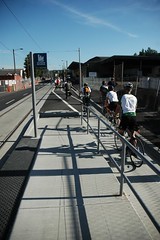
[This article was written by Chris Smith. Chris is a multi-modal transportation advocate who writes regularly on PortlandTransport.com. In the late 1990s he helped win neighborhood approval of the NW Bikeways plan that established the bicycle network in NW Portland and the Pearl District. He currently serves as chair of the Streetcar Citizens Advisory Committee and on the board of Portland Streetcar, Inc.]
A City of Bikes and Streetcars
I’ve enjoyed Libby Tucker’s two part series on bikes and streetcars in Portland (Part One – Part Two). It’s a very accurate portrait of the history of interactions between bikes and streetcars in our city.
But the framing “bikes and streetcars collide” misses what I think is the long-term prospect for a fantastic partnership between the two modes of transportation in Portland’s sustainable future.
The history has not always been smooth. As transportation chair for the neighborhood association in NW Portland in the late ‘90s, I was saddened that even as excitement grew over the imminent addition of streetcar to our neighborhood, veteran bike advocates like Rick Browning (he’s also the architect who designed the Hawthorne Bike Oasis) were raising concerns about the impact on cycling.
Since becoming chair of the Streetcar Citizens Advisory Committee in 2003, I’ve worked to continuously improve the relationships between the two modes, insisting that all major streetcar planning efforts have representation from the bicycle community. At the same time, in each new Streetcar project the engineering on the ground has gotten more friendly to bikes — from the center platforms on Harrison St., to the grade-separated bike lane routed behind the streetcar platform on Moody St. (in South Waterfront), to the about-to-be-built loop project that will include a cycle track on NE 7th Ave and a new bike boulevard on NW Marshall St. (and the de-commissioning of the truly awful bike lane through a streetcar platform on NW Lovejoy at 13th).
But those projects above still illustration more of a “collision avoidance” mentality. The full benefits of both modes won’t be realized until each embraces the other.

(and there aren’t many of them).
(Photo: Chris Smith)
My vision for positive cooperation between bikes and streetcars was affirmed when I visited Amsterdam in 2005 and found an urban environment where more than a third of trips were by bike, about a third by transit (mostly “tram”, which we call streetcar) and a little less than a third by auto. One of the lessons I took from Amsterdam was that cycling was comfortable because cars had largely been tamed. And it would certainly be much more difficult to tame traffic if a significant number of trips were not accommodated on transit. At the same time, a street environment slowed down to bicycle speed is also much friendlier to pedestrians (and we’re all pedestrians at either end of a transit trip).
But Portland is not Amsterdam (at least not yet). We have a long way to go, and a big part of the transition will be in changing land use patterns.
Cycle zone analysis, a new modeling tool developed by the Bureau of Transportation (PBOT) and Alta Planning, has demonstrated that cycling is more successful in neighborhoods that have lots of destinations grouped together within comfortable cycling (and walking) distance. These “20-minute neighborhoods” are one of Portland’s major planning goals and streetcar is one of the public-sector strategies that has been demonstrated to help focus the private-sector investment to create these neighborhoods. But there’s no point in building such neighborhoods if they’re not friendly to bikes. Efforts to designate the Pearl District as a “bicycle district” (and the initial steps to implement this, mostly focused on big increases in bike parking) reflect this.
Portland is now simultaneously updating its bicycle master plan and creating a 50-year vision for a streetcar system plan. That these are happening at the same time is a fantastic opportunity…
Portland is now simultaneously updating its bicycle master plan and creating a 50-year vision for a streetcar system plan. That these are happening at the same time is a fantastic opportunity and I’m delighted that I was asked to represent Portland Streetcar on the Bicycle Master Plan steering committee, and that Michelle Poyourow from the BTA is serving on the citizen committee overseeing the streetcar effort.
In looking at corridors for future streetcar routes we have required an analysis on whether the right-of-way is wide enough to accommodate both bikes and streetcars, or whether nearby parallel routes for bikes are available. The goal is to create mobility corridors that work harmoniously for multiple non-auto modes of transportation and help create land-use patterns that will both provide for streetcar ridership and create a rich environment for cycling and walking.
We can learn a lot from Europe, but this is not Europe and we have unique factors like the much higher standards for ADA compliance to incorporate as we develop our own uniquely North American design toolkit for incorporating both bikes and streetcars into our urban fabric. There’s no question we got off to a rocky start, but the growing mutual respect and cooperation between bikes and streetcars promises a bright future in which we work together to reduce our dependence on automobiles while building an even more livable city.
I invite all of you to apply your creativity and dedication to realizing this partnership.


